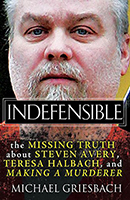 VERDICT: Touchdown!
VERDICT: Touchdown!
Indefensible: The Missing Truth About Steven Avery, Teresa Halbach, and Making a Murderer
By Michael Griesbach (New York, NY: Kensington Books, 2016). 304 pgs. $20.99. Order, www.amazon.com.
Reviewed by Kelly Kramer
Upon finishing this particular book, my main feeling was a huge sigh of relief. When Making a Murderer first aired last December on Netflix, I, like many Wisconsin residents who had already been more than familiar with the case (as well as others around the world who had never heard of it), devoured the entire series in one sitting.
However, unlike many viewers, I didn’t immediately jump on the Avery innocence bandwagon, primarily because as a lawyer I realized that the portions of the entire legal investigation, proceeding, and trial shown in the documentary likely only comprised a small piece of the whole story. I assumed that the documentary in its entirety was nothing more than a small, carefully edited piece designed to promote a certain narrative. After viewing, I was simply left with many questions about the case, thinking that it would be immensely helpful if someone would fill in the gaps that were so obviously missing from the documentary.
Want to Review a Book?
Please request a book and writing guidelines from Wisconsin Lawyer managing editor Karlé Lester, at klester@wisbar.org or (608) 250-6127. Reviewers may keep the book reviewed. Reviews of about 500 words are due within 45 days of receiving the book. Reviews are published, space permitting, in the order received and may be edited for length and clarity.
Thanks to Michael Griesbach and his research, those gaps have been filled. The questions that the series left me with have been answered. The amount of time, effort, and analysis that Griesbach put into researching this case, as well as Steven Avery’s entire life and history, is nothing short of outstanding. Unfortunately, the reality is that today’s binge-watching Netflix generation is probably not going to be as excited about a book laying out bare facts as they are about a cleverly edited piece of propaganda.
Thus, this book will appeal to lawyers much more than nonlawyers. Although Griesbach does a magnificent job of translating legal standards and factors into easy-to-understand language, the reality is that given our conspiracy-driven culture, many nonlawyer readers may find his explanations and analysis to be dry or an “excuse” to keep covering up what they believe is the truth.
It is somewhat challenging to write a thorough review of this book without giving away information that is best left to readers to sift through, ponder, and ultimately come to their own conclusion about. However, this book contains no “spoilers” about the case. It does not disclose some huge secret that reveals the “truth” about the Avery case at long last. Griesbach simply presents all the information in an accurate, thorough, and unbiased manner and leaves readers to draw their own conclusions using logic and common sense.
Kelly Kramer, Hamline 2013, is an attorney at Herrick & Hart S.C., Eau Claire, and a writer for Source HOV.
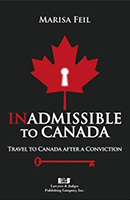 VERDICT: It’s a Keeper
VERDICT: It’s a Keeper
Inadmissible to Canada: Travel to Canada after a Conviction
By Marisa Feil (Tucson, AZ: Lawyers & Judges Publishing, 2015). 107 pgs. $35. Order, www.amazon.com.
Reviewed by Angela Bohmann
I had a personal reason for wanting to review this book. My husband’s family owns an island in Lake of the Woods, on the Canadian side of the border, and family members regularly travel to the cabin. My nieces and nephews have commented that they keep in mind the stricter Canadian laws on drinking and driving as they make (responsible) decisions regarding their use of alcohol. I wanted to read the book to learn how the Canadian rules relating to convictions for driving under the influence (DUI) operate.
The book is short, written by a Canadian immigration attorney who seems to have developed a practice assisting U.S. citizens convicted of various crimes in the United States or in Canada to be able to return to Canada. I learned that the Canadian system is complicated (not unlike the U.S. immigration system) and that admissibility after a conviction can depend on the type and circumstances of the offence. U.S. convictions are compared to their Canadian counterparts, with the adverse consequences determined by that assessment. It became clear to me that successfully navigating the Canadian system after a conviction would be difficult without assistance from competent Canadian counsel.
That may be the point of the book: If you or your clients have a U.S. DUI conviction and want to travel to Canada, it may be best to find Canadian assistance. Marissa Feil’s book can help you understand the rules, providing guidance regarding the process and the information that you will need, but in the end you might decide to call her to ask her to accept your case.
The book could have used a more rigorous proofreader. There were several typographical and grammatical errors. One in particular irritated me, the use of the plural pronoun (they, their) with a singular antecedent (individual, family member). Although this construct is regularly used in speech and in informal writing, I find it distracting in formal writing. A good editor could have reduced the incidence of the construct while avoiding the use of a masculine pronoun (his) where a gender-neutral pronoun was more appropriate.
While I hope never to need this book or Ms. Feil’s services for any family member, I will keep it on my bookshelf just in case.
Angela M. Bohmann, Boston College 1978, is admitted to practice in Wisconsin, Minnesota, and North Dakota. She practices employee benefits law in the Minneapolis office of Stinson Leonard Street LLP.
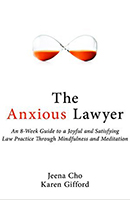 VERDICT: It’s a Keeper
VERDICT: It’s a Keeper
The Anxious Lawyer: An 8-Week Guide to a Joyful and Satisfying Law Practice Through Mindfulness and Meditation
By Jeena Cho & Karen Gifford (Chicago, IL: Ankerwycke, 2016). 251 pgs. $19.38. Order, www.amazon.com.
Reviewed by Nancy Thome
In The Anxious Lawyer: An 8-Week Guide to a Joyful and Satisfying Law Practice Through Mindfulness and Meditation, authors Jeena Cho and Karen Gifford, both lawyers, teach other lawyers how to use meditation and mindfulness to increase their professional satisfaction.
This is a very participatory book. For each week, the authors introduce a new meditation technique, as well as an off-the-cushion practice. For example, in week one, the meditation technique is a “body scan” and the off-the-cushion practice is “mindful showering.” The authors also encourage readers to keep a meditation journal, and the book contains several additional exercises. The last chapter gives suggestions for sustaining and expanding your meditation practice and a list of resources.
In addition, the authors teach lawyers how to use mindfulness to better perform specific tasks, such as conducting the initial client meeting and working with difficult opposing counsel. Each author shares her own professional and personal stories. Cho is a bankruptcy lawyer, and Gifford spent eight years as a litigation and enforcement lawyer for the Federal Reserve. The book also describes some of the scientific research on meditation, including the work of Dr. Richard Davidson, director of U.W.-Madison’s Center for Healthy Minds.
Although The Anxious Lawyer is written to benefit all lawyers, regardless of experience level, I was drawn to it because after 21 years of practicing law there are certain aspects of my job that feel rote, and I want to regain my enthusiasm. At the beginning of the book, one of the exercises is to set an intention for your meditation practice. The intention I chose is “my work is fulfilling.” After following the book’s eight-week program, I can honestly state that I do feel more fulfilled. In particular, the section on practicing law to serve your higher goals in week seven was helpful to me.
I also really liked the mantra-repetition meditation technique in week six. The simple mantra the authors suggest in the book, “let go,” resonates with me. I find myself repeating these two words in my mind all day long, whether I’m stuck in traffic, dealing with a difficult client, or irritated with my teenager.
Each meditation technique is available for free as a digital audio file at www.theanxiouslawyer.com. I suggest using the audio, at least for the first few days of each new meditation technique. I did not start using the audio until week five, and I regret not having started sooner. Week one’s body-scan meditation has 20 steps. It’s hard to meditate when you are trying to remember all 20 steps. It’s much easier to let the audio guide you through them.
What I liked most about The Anxious Lawyer is its lawyer-specific focus. I have read several other books on meditation, including 8 Minute Meditation by attorney Victor Davich, but none of them have focused specifically on lawyers. I also like that the book is straightforward and evidence based.
Nancy Thome, U.W. 1995, is a solo practitioner in Baraboo. On a recent backpacking trip to the Grand Canyon, she found herself repeating the “let go” mantra to overcome her fear of heights!
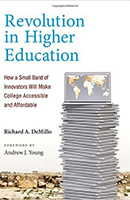 VERDICT: It’s a Keeper
VERDICT: It’s a Keeper
Revolution in Higher Education: How a Small Band of Innovators Will Make College Accessible and Affordable
By Richard A. DeMillo (Cambridge, MA: MIT Press, 2015). 360 pgs. $31.95. Order, mitpress-orders@mit.edu.
Reviewed by Megan A. Spranger
Revolution in Higher Education provides a well-rounded look at the current status of American colleges and universities and the future of higher education. Student debt is skyrocketing, enrollment numbers are dropping, and universities are caught in a drain-circling despair of how to fix, or even identify, the problem.
DeMillo begins by illustrating an issue that most lawyers know all too well – the debt from college degrees, undergraduate and especially graduate, is suffocating students and their bank accounts long after graduation. Families are feeling the crunch of lower paychecks resulting from degrees that were once valuable but are now required to simply attain a job in an oversaturated market.
DeMillo provides an insightful look at a revolution happening behind the scenes and chronicles the educators he categorizes as heroes. These academics are introducing new ways of educating, integrating an online world with the educational one. He explores Massive Open Online Courses (MOOC), where upwards of 15,000 students from around the world can take an artificial intelligence course by a professor at Stanford or introduction to electrical engineering at MIT, and Khan Academy, a series of short instructional videos produced by Salman Kahn exploring topics such as calculus, both of which provide free education to people around the world.
DeMillo also examines how universities are attempting to cope with the sudden changes in the higher-education landscape. Reputation, branding, and social networking have all taken their toll. The ability of students, parents, and the general public to make commentary on institutions and their decisions has created a shift in higher education’s public image. Online petitions and protests – some consider it a growing mob mentality – illustrate the double-edged sword of the internet.
Ultimately, DeMillo makes the argument to encourage more changes and improvements to the system of higher education, to make it more accessible, more affordable, and more adept at creating future innovators, bringing higher education into the present. The book is well written and carefully constructed to give a history of higher education, develop the reader’s understanding of the innovations occurring and the heroes behind them, and thoughtfully examine where higher education can go from here.
Megan A. Spranger, Valparaiso 2012, is an associate with Silton, Seifert, Carlson S.C., Appleton.
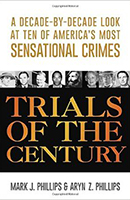 VERDICT: It’s a Keeper
VERDICT: It’s a Keeper
Trials of the Century: A Decade-by-Decade Look at Ten of America’s Most Sensational Crimes
By Mark J. Phillips & Aryn Z. Phillips (Amherst, NY: Prometheus Books, 2016). 340 pgs. $12.59. Order, www.amazon.com.
Reviewed by Craig R. Johnson
Trials of the Century: A Decade-by-Decade Look at Ten of America’s Most Sensational Crimes examines one high-profile criminal trial in each decade of the 20th century. The cases range from those now fairly obscure, such as the trial of Harry Thaw, a Pittsburgh millionaire, for the murder of a romantic rival, to (what else?) the O.J. Simpson case. Each gets a chapter in which the background of the main characters is briefly sketched, the crime itself and subsequent trial are examined in some detail, and then the publicity and postscript are laid out.
There are plenty of interesting details about the time period of each case and the city in which it occurred. The larger societal reaction to the crime and the participants is examined. For example, the case of Leo Frank, who is alleged to have murdered a teen-aged girl in the factory where she worked and in which Frank was a manager, was infected with anti-Semitism. Frank was charged and convicted despite the fact that other, more likely suspects were plentiful. The U.S. Supreme Court heard and rejected Frank’s motion for a retrial. Justice Oliver Wendell Holmes was one of two dissenters; he called the case an example of mob law. Holmes was right – after the governor of Georgia commuted Frank’s sentence, a vigilante mob broke into the prison where he was being held and lynched him.
The authors also examine the Lindbergh baby kidnapping, in which the exceedingly odd Bruno Hauptmann was represented by a perhaps even stranger attorney named Edward J. Reilly. Reilly is described as a “larger-than-life, wildly famous” defense attorney, but, as recounted here, his advocacy on behalf of Hauptmann was largely ineffectual. Other defendants discussed in the book include Fatty Arbuckle, Sam Sheppard, and Richard Speck, who is perhaps the most terrifying of the 20th century’s legion of serial killers. His gruesome attack on eight student nurses in Chicago in 1966 was the epitome of the senseless, purely random killing that provides fodder for horror movies and true-crime cable TV specials.
The source material in the book is drawn largely from secondary material and is somewhat suspect at times. The chapter on Fatty Arbuckle, for example, cites as a source TruTV.com. The chapter on Charles Manson and the Tate-LaBianca murders relies too heavily on Vincent Bugliosi’s book Helter Skelter, although it would be hard to completely ignore such a comprehensive book by one of the trial’s main participants.
Overall, Trials of the Century is a fun read and provides an entertaining overview of each of these sensational cases from the last century. It doesn’t sell itself as a scholarly examination of the intersection between crime and the media coverage it generates and doesn’t pretend to delve deeply into larger questions about how lurid crime news can drive public opinion and criminal justice policy. But if you’re a trial junkie looking for a good beach read, it does the trick.
Craig R. Johnson, U.W. 1993, practices with Sweet & Associates LLC, Milwaukee.
